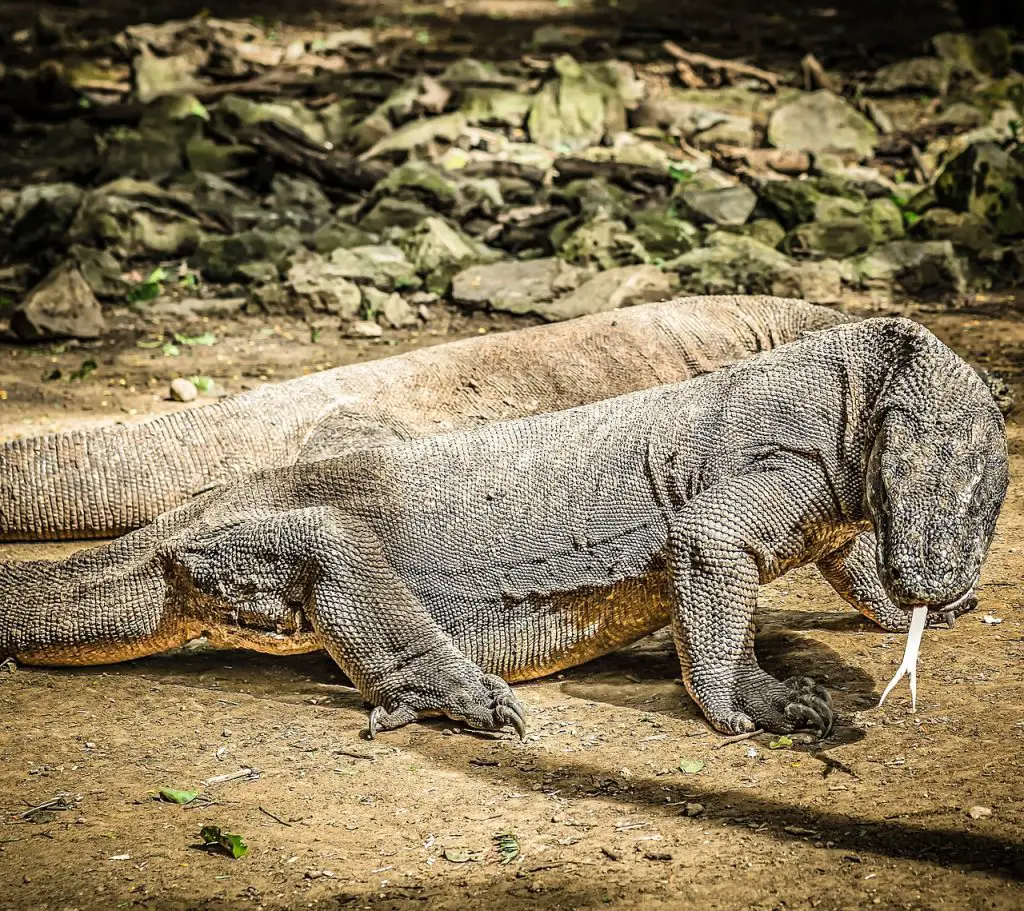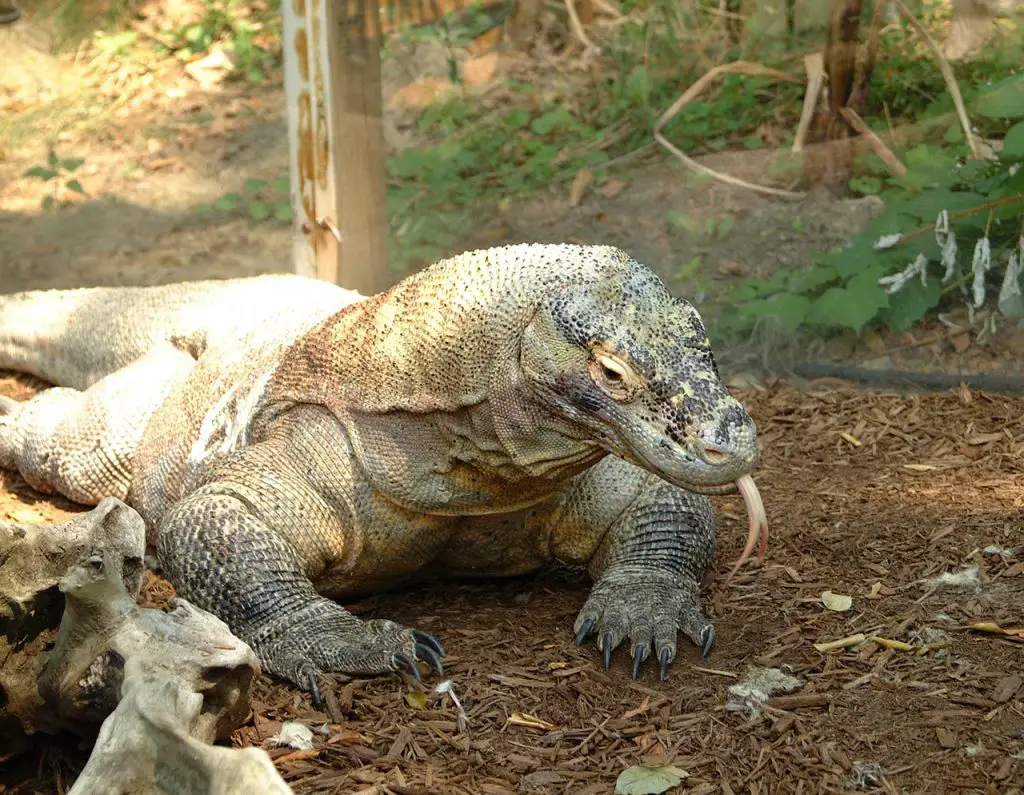Monitor lizards are intriguing reptiles within the Varanus genus. There are over 75 different species of monitor lizards. We will explore everything you’ve ever wanted to know about monitor lizards. Plus, you’ll probably learn something that you didn’t expect about these large lizards.
Key facts:
- Some monitor species, like the Komodo dragon, can grow up to 10 feet long, making them the largest lizards on Earth!
- The Komodo dragon’s saliva contains harmful bacteria, which can weaken and eventually kill their prey, making them the only known venomous lizards.
- Monitor lizards are highly skilled swimmers and can effortlessly traverse both freshwater and saltwater habitats.
- With their keen senses and intelligence, monitor lizards are proficient predators, able to stalk and ambush their prey with impressive precision.
- Female monitor lizards diligently guard their nests, and some species even exhibit “oviparous viviparity,” where they incubate eggs inside their bodies before giving live birth to their offspring.
What are Monitor Lizards?

Monitor lizards are a diverse group of reptiles belonging to the family Varanidae. These ancient creatures are found across various continents, with the most iconic being the Komodo dragon native to Indonesia. Monitor lizards are renowned for their impressive size, with some species reaching lengths of up to 10 feet, making them the largest lizards on Earth.
Monitor Lizards: Scientific Classification
Here’s a breakdown of the scientific classification of monitor lizards:
- Kingdom: Animalia
- Phylum: Chordata
- Class: Reptilia
- Order: Squamata
- Suborder: Lacertilia
- Family: Varanidae
The Family Varanidae consists of monitor lizards, which are further divided into various genera and species. Some well-known genera within this family include Varanus, the most diverse genus with over 50 recognized species, and Varanus komodoensis, known as the Komodo dragon.
Why Are They Called Monitor Lizards?
Monitor lizards’ keen and alert nature, coupled with their remarkable intelligence and predatory prowess, earned them the moniker “monitors.” These reptiles were seen as vigilant sentinels of their habitats, always on the lookout for danger and opportunity alike. The name “monitor lizard” has since become a widely accepted term to refer to these impressive and ancient creatures.
Where Do Monitor Lizards Live?

Monitor lizards exhibit an impressive range of distribution, with various species inhabiting diverse habitats across the globe. They can be found in Africa, Asia, Australia, and some Pacific Islands. In Africa, the Nile monitor (Varanus niloticus) is a common sight near bodies of water, such as rivers and swamps.
Across Asia, monitor lizards are widespread, with species like the Bengal monitor (Varanus bengalensis) thriving in diverse environments, including forests, grasslands, and urban areas. The iconic Komodo dragon (Varanus komodoensis) is native to a few Indonesian islands, including Komodo, Rinca, and Flores.
Australia is home to several monitor lizard species, with the perentie (Varanus giganteus) being the largest. These reptiles can be found across arid regions and semi-deserts.
Additionally, monitor lizards display adaptability, venturing into different ecosystems. Some species, like the water monitor (Varanus salvator), are equally adept in aquatic environments, while others, such as the tree-dwelling green tree monitor (Varanus prasinus), spend most of their time in the canopies of tropical forests. The wide geographical distribution and habitat preferences of monitor lizards make them a truly captivating and diverse group of reptiles.
Monitor Lizards: Physical Features
Monitor lizards have robust bodies and elongated tails. With sturdy limbs and sharp claws, they are well-equipped for both terrestrial movement and climbing. Their heads are distinct, featuring powerful jaws and keen eyesight that aids in their hunting prowess.
The scales covering their bodies have a glossy appearance, providing a protective armor-like layer. Some species may display vivid patterns and colors, adding to their visual allure.
Their sizes vary significantly among species, with some smaller monitors measuring just a few feet in length, while others, like the Komodo dragon, can reach up to 10 feet, making them the largest lizards in the world.
One of the most remarkable features of these lizards is their forked tongues, which they constantly flick to gather scent particles from the air, enhancing their sense of smell.
Behaviors
Despite being primarily terrestrial, many species are adept swimmers, using their powerful tails to navigate through water with ease.
Additionally, these lizards are skilled predators. They often employ a patient stalking approach before launching into swift pursuits to catch their prey. Their intelligence and agility allow them to capture a wide variety of food, from insects and small mammals to birds and other reptiles.
Nesting
Female monitors are attentive to their nests, carefully laying and guarding their eggs until hatching. In some species, such as the Komodo dragon, mothers even provide additional protection and aid for their offspring in their early stages of life.
Additionally, some species display social behaviors. For instance, the Nile monitor lizards have been observed engaging in communal nesting, where multiple females lay their eggs in the same location.
Diet
Monitor lizards are formidable carnivores with diverse and voracious appetites. Their diet primarily consists of live prey, which they actively hunt and capture. From insects and small mammals to birds and reptiles, these lizards showcase their predatory prowess in a wide range of food choices.
Insects and arachnids serve as delectable morsels for smaller monitor species, showcasing their agility and quick reflexes during hunts. As they grow larger, their diet expands to include rodents, birds, and other reptiles.
Some monitor lizards are skilled scavengers, taking advantage of carrion and leftover food sources. This scavenging behavior aids in their survival in challenging environments where prey may be scarce.
Notably, the Komodo dragon, a famous monitor species, can tackle larger prey. These formidable giants can prey on water buffalo, deer, and wild pigs, utilizing their powerful jaws and bacteria-laden saliva to bring down and consume large animals.
Habitat
Monitor lizards showcase impressive adaptability, occupying a diverse range of habitats across the globe. However, their preferences may vary depending on the species. Generally, these reptiles favor warm and tropical environments, thriving in regions with ample sunlight and moderate humidity.
Many monitor species favor grasslands and savannas, which provide an ideal balance of open spaces for basking and vegetation for cover and hunting opportunities. Forested areas, whether tropical rainforests or dry woodlands, are also popular habitats for various monitor lizards, especially those with climbing abilities.
In aquatic environments, some monitor species, like the Asian water monitor (Varanus salvator), live near rivers, lakes, and mangroves. These excellent swimmers can effortlessly move through water and may even dive in pursuit of aquatic prey.
Certain monitor lizards, such as the perentie (Varanus giganteus) in Australia, thrive in arid deserts and semi-deserts, showcasing their adaptability to more extreme conditions.
Are Monitor Lizards Intelligent?
These lizards exhibit an impressive level of intelligence, making them formidable and successful predators in their respective ecosystems. Their sharp senses and keen awareness of their surroundings reflect their cognitive abilities. As skilled hunters, they often employ patience and stealth to stalk their prey before launching swift and calculated attacks.
Furthermore, some species demonstrate social intelligence, as observed in their communication and nesting behaviors. For instance, communal nesting and maternal care in certain monitor lizards underscore their complex social structures.
While their intelligence may not be on par with some mammals or birds, these lizards’ cognitive prowess plays a pivotal role in their survival and success as apex predators, showcasing their status as intelligent and fascinating creatures in the realm of wildlife.
Threats
Monitor lizards, despite their resilience, face several threats that impact their populations in various regions:
- Habitat Loss: Deforestation and urbanization are significant threats to these lizards. As natural habitats are cleared for human development or agriculture, these reptiles lose their crucial nesting sites, foraging grounds, and shelter, leading to population decline.
- Illegal Wildlife Trade: Monitor lizards are sought after in the illegal pet trade and for their skins, which are used in traditional medicine or fashion industries. This exploitation puts immense pressure on wild populations and threatens their survival.
- Hunting and Poaching: In some regions, people hunt these lizards for their meat or perceived medicinal properties. Unsustainable hunting practices can disrupt the ecological balance and endanger their populations.
- Human-Wildlife Conflict: In areas where monitor lizards come into close contact with humans, conflicts may arise due to perceived threats to livestock or pets. Unfortunately, these conflicts often lead to retaliatory killings of these reptiles.
- Pollution and Climate Change: Pollution and climate change can have adverse effects on monitor lizard habitats and prey availability. Changes in temperature and weather patterns may disrupt their breeding cycles and overall ecosystem dynamics.
Conservation Efforts
Conservation efforts to protect monitor lizards have gained momentum worldwide, aimed at preserving these remarkable reptiles and their diverse habitats:
- Habitat Protection and Restoration: Various organizations and governments work to establish protected areas and reserves that encompass key monitor lizard habitats. By safeguarding these regions from human encroachment and deforestation, their critical nesting and foraging sites are preserved.
- Anti-Poaching and Law Enforcement: Collaborative efforts are in place to combat illegal wildlife trade and poaching of these lizards. Stricter enforcement of laws and penalties deters illegal hunting and helps curb the demand for monitor lizard products in the black market.
- Community Education and Outreach: Conservation groups engage with local communities, raising awareness about the ecological importance of these lizards. Promoting coexistence and sustainable practices help mitigate human-wildlife conflicts and garner support for conservation initiatives.
- Research Programs: Scientists conduct research on monitor lizard populations to better understand their behavior, habitat needs, and ecological roles. Monitoring programs track population trends, providing crucial data to inform conservation strategies.
- Captive Breeding and Reintroduction: Some organizations run captive breeding programs to breed and rehabilitate injured or confiscated lizards. When possible, individuals are reintroduced into suitable habitats to bolster wild populations.
Frequently Asked Questions
You have questions. I have answers.
How venomous are monitor lizards?
Monitor lizards are not venomous. While some species, like the Komodo dragon, have harmful bacteria in their saliva that can weaken their prey over time, they do not possess venom glands like snakes or certain other reptiles.
Are monitor lizards aggressive to humans?
Monitor lizards are generally not aggressive towards humans. They are shy and elusive creatures, and when encountered, they typically try to avoid human contact. However, like any wild animal, they may react defensively if they feel threatened or cornered.
Is the Komodo dragon a monitor lizard?
Yes, the Komodo dragon (Varanus komodoensis) is a type of monitor lizard. It is the largest and most well-known species in the Varanidae family and is found primarily on a few Indonesian islands, including Komodo, Rinca, and Flores.
Final Take
Monitor lizards encompass a wide diverse group of lizards that live on several continents. While the Komodo dragon might be the most recognized species, it’s really just the tip of the iceberg.